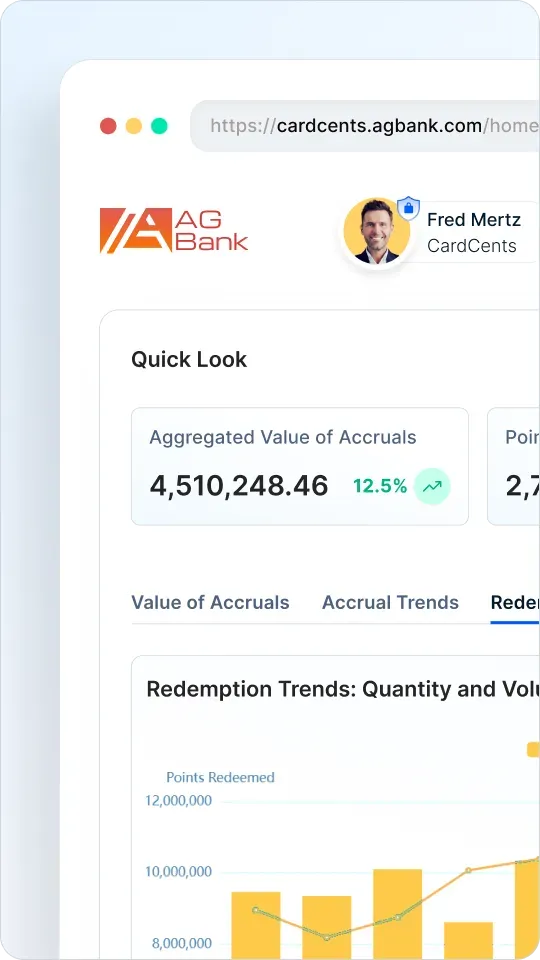On this page
Did you know that 81% of customers are more likely to stick with a brand that offers a loyalty program? Yet, building a loyalty program ecosystem that’s on-brand, engaging, and scalable remains challenging for many businesses.
Enter the white-label loyalty program, an increasingly popular solution that lets brands deploy fully branded, feature-rich programs without starting from scratch. Whether in retail, travel, banking, or wellness, a white-label loyalty program offers the speed, flexibility, personalization, and scalability a brand looks for.
This article will explore how white-labelled loyalty programs operate, why they’re the smarter choice for modern businesses, and the trends shaping their future.
What is a White-Labelled Loyalty Program?
A white-labelled loyalty program is a ready-made loyalty management solution that businesses fully customize and brand as their own. This is done without having to build the infrastructure from scratch.
It allows companies to offer personalized rewards, track customer engagement, and manage loyalty operations under their unique brand identity while leveraging a third-party provider's technology, design, and expertise.
Unlike co-branded or off-the-shelf solutions, white-label programs offer the best of both worlds. They combine the benefits of custom solutions with the flexibility of off-the-shelf solutions. Brands get complete brand ownership with enterprise-grade capabilities.
Businesses can tailor the interface, messaging, reward structure, and engagement strategies to match their customer experience without the cost, time, and complexity of in-house development.
For example, a retail brand launches a fully branded mobile loyalty app with points, rewards, and gamified tiers. A loyalty platform like Loyalife powers the app, but it appears to be a native experience for the customer.
How Do White-Label Loyalty Programs Benefit Businesses?
A white-label loyalty program is an effective route for brands seeking to establish deep customer relationships without the cost and complexity of creating a custom system from scratch.
Here are some benefits they bring to the table:
Faster time to market
Launching a loyalty program from scratch requires months of development, testing, and iterations. With a white-labelled solution, brands can go live in weeks.
The backend technology is already built and tested; your team customizes it to align with your brand identity and customer strategy.
Cost-efficiency without compromise
Building an in-house loyalty platform involves upfront development costs and ongoing maintenance, upgrades, and security expenses.
White-labelled platforms operate on a subscription or service-based model, dramatically reducing capital expenditure while offering enterprise-grade features and scalability.
Retain brand identity
Although a third party provides the technology, a white-labeled loyalty program is fully customizable.
From logos and colors to customer communications and reward structures, all the elements and the entire experience are crafted to feel uniquely yours. Customers will interact with your brand, not the loyalty management solution provider.
Access to a tried and tested technology
White-label providers like Loyalife bring years of domain expertise, best practices, and technology refinement.
You benefit from a product tested across industries and optimized for performance, security, and engagement without having to undergo the learning curve yourself.
Data ownership and customer insights
Even though the platform is white-labelled, you retain complete control over your customer data.
Brands track behaviors, segment audiences, measure ROI, and personalize offers using real-time insights, powering smarter marketing decisions and more meaningful customer relationships.
Omnichannel consistency
Modern loyalty programs must operate seamlessly across web, mobile, in-store, and social channels.
White-labelled platforms are designed with omnichannel engagement in mind, ensuring a consistent customer experience whether someone is shopping online, using your app, or visiting your physical store.
Key Components of a Successful White-Label Loyalty Program
To maximize the impact of a white-labelled loyalty program, businesses must look beyond aesthetics and ensure that the solution is built on a strong, flexible, and customer-centric foundation.
Below are some of the essential components that define long-term success:
Custom branding and seamless UX/ UI
A white-label loyalty program should look and feel like a natural extension of your brand.
That means having:
- Custom logos, brand colors, fonts, and visual elements
- Consistent tone of voice in messaging, across channels
- Intuitive, mobile-friendly interfaces that are easy to navigate
Why it matters: A branded experience increases trust, brand recall, and user engagement. Members of the loyalty program feel like they’re interacting with your business, not a third-party system.
Integration with existing systems
Your loyalty program must connect seamlessly with your current technology stack to function efficiently.
A white-label loyalty program should:
- Sync with your POS systems for real-time point accrual and redemption
- Integrate with CRM platforms to enrich customer profiles and enable personalized communication
- Work with your eCommerce platform for unified loyalty experiences across online and offline stores
- Connect to marketing automation tools for campaigns and analytics systems for unified reporting and analytics
Why it matters: Integrations eliminate data silos, reduce manual effort, and makes sure that every customer interaction whether in-store or online adds value to the loyalty journey.
Flexible and personalized reward structures
A modern loyalty program goes beyond a one-size-fits-all approach. It should offer points, cashback, coupons, vouchers, exclusive access, or rewards.
To keep customers engaged with the brand, consider developing tiered memberships that reward loyalty over time. Ensure that rewards are personalized based on purchase history, preferences, and behavioral data.
Why it matters: When rewards feel relevant and achievable, customers are more likely to be engaged and spend more.
Omnichannel accessibility and engagement
As a brand, you need to set consistent expectations for your customers, regardless of the channel or method through which they interact with your brand.
An effective loyalty program should be accessible through mobile apps, websites, in-store terminals, and customer service. It should enable customers to seamlessly earn and redeem points across all channels and provide real-time updates on their loyalty status, points balance, and offers.
Why it matters: An omnichannel loyalty program ensures a seamless and convenient experience that keeps customers returning, regardless of location.
Real-time data and customer insights
Loyalty programs generate a wealth of customer data. A high-performing loyalty program solution offers real-time dashboards that track enrollments, redemptions, engagement, and return on investment (ROI).
By leveraging a white-label loyalty app, brands can segment their tools to group customers by behavior, demographics, and purchase history.
Why it matters: Actionable insights enable brands to refine their loyalty strategies and deliver highly personalized customer experiences.
Gamification and engagement features
Programs should incorporate challenges, badges, levels, and achievements to make loyalty fun and habit-forming.
By incorporating gamified elements, such as progress bars or trackers, you can enhance customer retention and effectively determine the next reward for customers.
Why it matters: Gamification introduces a sense of play and achievement, turning occasional buyers into loyal brand advocates.
Scalable and modular design
As your brand expands, your loyalty program should grow along with it. A scalable platform allows expansion into new regions, languages, or customer segments.
The loyalty solution provider will continue adding new features per the latest customer loyalty trends.
Why it matters: A rigid loyalty system can become a bottleneck, while a modular, scalable one can become a growth driver.
Industries Best Suited for White-Label Loyalty Programs
While loyalty is a universal business need, some industries are uniquely positioned to benefit from white-labelled loyalty programs due to the nature of their customer interactions, high competition, and frequency of engagement.
Here’s how white-label loyalty solutions create impact across key sectors:
Retail and e-commerce
The retail and e-commerce sectors are highly competitive and price-sensitive, and customers often choose brands that deliver the best value or experience.
A white-labelled loyalty program allows brands to offer personalized discounts and product recommendations, gamified earning and referral systems, and tier-based programs to increase repeat purchases and lifetime value.
Retailers rapidly deploy a branded experience across online and offline stores, use data to tailor promotions, and convert occasional buyers into loyal advocates without building a platform from scratch.
Hospitality and travel
Customer retention is vital in hospitality and travel. Travelers and guests often seek added value, exclusive perks, and recognition for their loyalty.
A white-label solution allows hotel loyalty programs to form tiered programs for frequent travelers or VIP guests. The solution seamlessly integrates with booking systems and mobile check-in.
A leading hotel chain in Indonesia used Loyalife to launch a fully branded, multi-tiered loyalty program across 30+ properties. With seamless integration into their booking platform and mobile app, the hotel could reward frequent stays, encourage direct bookings, and offer localized partner rewards.
The hotel chain witnessed increased repeat bookings, direct channel usage, and guest satisfaction while maintaining complete control over brand experience and customer data.
Financial services
Banks, fintech platforms, and credit card providers operate in a trust-driven environment where customer engagement often hinges on tangible value and convenience.
Loyalty programs reward spending behaviors with cashback, air miles, or merchant offers. They encourage the usage of specific cards or digital wallets and offer status-based benefits (e.g., Gold and Platinum tiers).
A white-label loyalty solution enables financial institutions to offer a fully branded and secure rewards experience that strengthens customer relationships and drives usage, without risking compliance or operational complexity.
Healthcare and wellness
Wellness brands, fitness centers, and healthcare providers increasingly compete on experience and engagement.
Loyalty programs reward healthy behaviors or regular checkups, encourage continued usage of health services or fitness apps, and offer personalized wellness tips, classes, or partner perks.
With a white-labelled approach, organizations build trust and brand equity by providing value beyond services through highly personalized, branded loyalty experiences that foster ongoing engagement and retention.
Build vs. Buy: Why Brands Prefer White-Label Loyalty Program Solution
As loyalty becomes a strategic priority, businesses often face a critical decision: Should we build our loyalty program from scratch or buy a white-labelled solution?
While building might seem more customizable, white-label platforms offer a faster, more innovative, and more scalable path to loyalty success.
Challenges of building a loyalty program from scratch
Creating a custom loyalty solution requires more than an idea and a development team.
Brands that opt to build in-house often encounter a face:
- High development costs go into building a secure and feature-rich loyalty system.
- The development cycles are time-intensive and might take over a year until the first version is live.
- Connecting the loyalty system with CRMs, POS systems, eCommerce platforms, and analytics tools adds technical overhead.
- It needs ongoing maintenance to consistently update the solution, fix bugs, make it scalable, and work on security patches.
- Internal teams may struggle to keep up with emerging trends like gamification, AI-driven personalization, or mobile-first experiences.
Why white-label solutions like Loyalife make more sense
White-label loyalty platforms eliminate these pain points by offering a ready-to-deploy infrastructure, designed for brand customization and fast go-to-market.
They allow businesses to launch faster with enterprise-grade capabilities. The solutions reduce the risk and development burden, focusing on strategy and customer experience rather than backend complexity.
White-label loyalty program reseller vs. Custom Development
How Loyalife Enables Seamless White-Label Loyalty Programs
Loyalife empowers brands to launch an AI-powered, sophisticated, fully branded loyalty program. With their white labelling capabilities, brands get to build highly personalized, scalable loyalty program ecosystems.

Let’s understand how Loyalife is your go-to solution for any loyalty program management needs:
Custom branding and modular design
Loyalife is built from the ground up for white-label deployment. That means businesses from any sector get to launch a loyalty program that reflects their visual identity, logos, colors, fonts, and tone of voice.
The loyalty program solution provides a frictionless user experience through branded portals, mobile apps, and communications.
In addition, Loyalife’s modular platform allows businesses to start with core features and scale gradually, adding new capabilities like gamification, partner networks, or referral programs as their needs evolve.
APIs, integrations, and omnichannel engagement
Loyalife seamlessly plugs into your existing tech stack and partner integrations, with robust APIs and pre-built connectors.
It enables real-time interactions across:
- POS systems for in-store rewards and redemptions
- CRMs for data enrichment and personalized campaigns
- eCommerce platforms for synchronized online loyalty experiences
- Mobile apps and web portals for customer self-service and engagement
Whether customers shop online, book a hotel room, or visit a physical store, Loyalife ensures their loyalty experience is consistent, real-time, and rewarding across every touchpoint.
Intelligence, automation, and personalization
The loyalty program solution allows brands to set up automated campaigns triggered by behavior (e.g., birthdays, repeat visits, milestone achievements). They also provide built-in analytics dashboards to monitor engagement, redemptions, and ROI.
By removing the manual lift, Loyalife enables marketing teams to focus on strategy while delivering more relevant, timely loyalty experiences that drive real results.
Common Misconceptions About White-Label Loyalty Programs
Despite their growing popularity and proven value, white-label loyalty programs are sometimes misunderstood.
Let’s clear the air by addressing a few common misconceptions and understanding why they no longer hold.
It’s just a template
Many believe white-label solutions are rigid, one-size-fits-all templates. Today’s platforms are highly configurable, offering extensive flexibility in how programs are structured, branded, and evolved.
With Loyalife, businesses choose everything from point logic and tier structures to rewards catalogs, partner ecosystems, gamified elements, and communication flows.
It’s not about fitting into a mold but building your program faster, using a robust foundation.
It does not truly feel ours
Another common myth is that white-label platforms dilute brand identity or take customer data ownership. White-label solutions give you full control and help with complete branding.
Everything reflects your brand, not the platform provider, from domain and design to tone and messaging. And don’t worry; your customer data will stay yours.
A practical solution like Loyalife ensures businesses retain full access and control over user data, behavior, and insights while complying with global privacy laws.
It’s hard to scale
Modern white-label solutions are designed to scale effortlessly, whether adding new locations, onboarding partners, expanding globally, or supporting millions of users.
Best Practices for Launching a White-Label Loyalty Program
Here are some best practices to help you launch and scale with confidence:
Define clear goals and KPIs
Defining specific, measurable goals ensures your program stays aligned with your broader business strategy, whether it’s increasing repeat purchases, improving customer retention, or boosting average order value.
From there, KPIs such as enrollment rate, redemption rate, repeat purchase frequency, and customer lifetime value (CLV) should be established.
Ensure full brand alignment
Your loyalty program should be a natural extension of your brand. Ensure everything from visual elements to tone, language, and user flows matches your brand personality.
Focus on user experience and simplicity
If your loyalty program feels confusing or complicated to use, customers won’t engage with it. Make the experience intuitive and mobile-friendly, simple to join, easy to understand, and rewarding immediately (e.g., welcome bonuses or quick wins).
Regularly Review and Optimize Based on Analytics
A loyalty program is not “set it and forget it.” Use built-in analytics to track member engagement and redemption patterns, and continue to test and tweak reward structures
Future Trends in White-Label Loyalty Programs
The next generation of white-label loyalty solutions is not just about points and perks; it’s about creating intelligent, immersive, and interconnected experiences.
Here are the key trends shaping the future of white-label loyalty programs:
AI-driven personalization at scale
With AI-powered white-label platforms, brands can analyze vast volumes of customer data to predict churn risk and trigger retention offers. They can also offer customers personalized rewards based on past behaviors, preferences, and engagement patterns.
AI makes loyalty feel intuitive and individually tailored, ensuring customers get the right offer at the right time, without manual effort.
Blockchain and NFTs in loyalty
Blockchain technology brings security, transparency, and transferability to loyalty.
Forward-thinking programs are exploring:
- Tokenized rewards that can be traded or redeemed across ecosystems
- NFT-based collectibles or access passes as exclusive loyalty rewards
- Immutable tracking of points and transactions to prevent fraud
White-label platforms will increasingly offer plug-and-play blockchain modules, allowing brands to dip into Web3-enabled loyalty without building complex infrastructure.
Cross-brand and coalition loyalty
The future of loyalty is not siloed; it’s collaborative. Coalition loyalty programs that span multiple brands offer greater value and flexibility to customers while enabling shared customer insights and co-marketing opportunities.
Such loyalty programs offer broader redemption options and earning opportunities.
Conclusion
White-labelled loyalty programs help brands launch fast, scale easily, and deliver personalized, omnichannel experiences that customers remember.
Loyalife makes building and managing a sophisticated, fully branded loyalty program easy without the operational overhead. From AI-powered personalization to modular integrations and gamified engagement, we provide everything you need to turn customers into loyal advocates.
Want to know more about Loyalife? Book your demo to see how a white-label solution will transform your CX.


